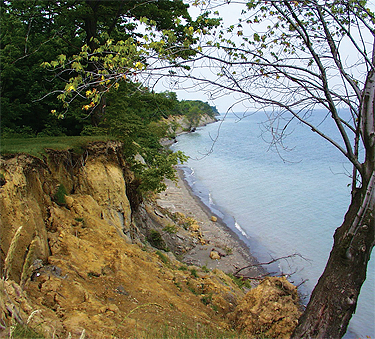Two Key Properties Added to Roderick Wildlife Reserve

David M. Roderick Wildlife Reserve.
Erie coastline to add 195 acres to the David M. Roderick Wildlife Reserve since December 2010. The 3,409-acre Erie County reserve, which WPC helped to establish in 1991, provides opportunities for hunting, bird-watching, cross-country skiing, hiking and other recreational activities.
Both the original reserve and the newest additions have been conveyed to the Pennsylvania Game Commission, and are designated as State Game Land No. 314.
In addition to white-tailed deer, American woodcock, and other game species, the newly acquired properties support various species of breeding birds, as well as plants not found in Pennsylvania outside the Lake Erie watershed. The state-endangered variegated scouring rush and the state-threatened small-headed rush grow in the steep bluffs above the Lake Erie beach.
The wooded parts of the properties are lakeplain swamp forests, which are flat woodlands with interconnected vernal pools. The dominant tree species in the area is state-endangered pumpkin ash.
Both acquisitions received funding from the Great Lakes Restoration Initiative, the Joint Venture Habitat Restoration and Protection Program and the Pennsylvania Game Commission. Additional funds for the first parcel came from the Erie Community Foundation and the Pennsylvania Department of Conservation and Natural Resources’ Community Conservation Partnership Program.

Pumpkin ash tree.
The Conservancy is working with partners to restore a remnant patch of black oak savanna habitat along undeveloped stretches of Lake Erie shoreline including Erie Bluffs State Park.
The black oak savanna habitat, which was common to that area before cities, farms and vineyards populated the region, is a sandy, almost treeless barren that supports a high diversity of plants and a number of rare species including wild lupine, a perennial plant with blue flowers. Erie Bluffs State Park contains one the few remaining patches of this globally rare habitat.
“The black oak savanna supports a number of grasses and other herbaceous plants that aren’t found together in the same way in other parts of the state,” said Ephraim Zimmerman, WPC’s ecological assessment manager for the Pennsylvania Natural Heritage program.
The restoration work is focused on the removal of various plant species, mostly black locust trees. The tree is native to Pennsylvania but an aggressive invader of sandy dunes and beach ridges in the Great Lakes. The Conservancy is working with the Pennsylvania Department of Conservation and Natural Resources and other partners to remove invasive plants to stimulate the recovery of native species and allow plants to grow naturally.
“We’re treating bush honeysuckle, Asian bittersweet vines and garlic mustard,” said Zimmerman. “We have also removed over three acres of black locust trees, which are more native to the Appalachian Mountains, but can really take over sandy ecosystems like the bluffs and Presque Isle.”
As a result, black oak seedlings and other native sand-barren plants have begun to grow back. New growth of wild lupine was discovered this past summer in the restoration area. Regeneration of native trees is also expected as the nearly 100 acres of cornfield that surround the savanna are taken out of production.
In addition to the work at Erie Bluffs, WPC is assembling a group of local experts and land managers to develop a weed management plan for the Lake Erie region in Pennsylvania, including Presque Isle State Park at the Gull Point Natural Area. The plan will engage landowners in locating invasive weeds, prioritizing treatment areas and identifying methods for control.
WPC is reaching out to other landowners in the Roderick Reserve area, and elsewhere in Western Pennsylvania. “There are many options available to property owners who want to play a vital and lasting role in the preservation of natural resources,” said Jane Menchyk, WPC land protection specialist. “Tax incentives for donations of property and conservation easements are available for landowners.”
